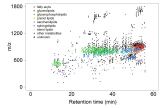Lipidomics

Lipidomics is the quantitative and molecular characterisation of entire pathways and networks of lipids in a given cell, tissue, body fluid, or whole organism on a molecular level and linking it to a biological question (e.g. blood clotting, cardiovascular disease, cancer).
Scatterplot of an Orbitrap high resolution LC-MS analysis of the human plasma lipidome
The lipidome is part of the metabolome and the widely different physicochemical properties of most lipids in comparison to more polar and water soluble metabolites encourages their separate analysis. Lipids act as nutrients, play essential structural roles, and mediate a broad range of physiological and pathophysiological processes in biological systems. Especially their involvement in important biological processes such as blood clotting, mediating inflammation or as signalling molecules makes them an interesting target for the discovery of new biomarkers which also leads to a better understanding of the underlying biological processes. Such information and insights are mandatory for developing new treatments and personalised medicine.
Considering the most common building blocks for complex lipids, up to 180,000 different lipids can exist in theory. The most important lipid database (LIPID MAPS Structural Database; www.lipidmaps.org) comprises over 40,000 unique structures of different lipids from mammals, plants, bacteria, fungi, algae, and marine organisms, which are categorised into eight different lipid classes (see figure below).
Analysing the whole lipidome is often challenging because of the complexity of the sample matrix, the vast number of lipids, and the highly different concentrations (0.01 nM to 1,820,000 nM in the same human plasma sample). Due to these challenges, lipidomics is a relatively recent research field which has been driven mostly by developments in mass spectrometry.
We use two dimensional liquid chromatography coupled to ion mobility high resolution mass spectrometry (2D LC-IM-qTOF-MS) to analyse the lipidome in various biological samples.
We are interested:
- in the development of new multidimensional analytical approaches to characterise the lipidome of biological samples
- in disease related changes of the lipidome and lipid related pathways
- in the identification of lipid biomarkers for the use in personalised medicine


